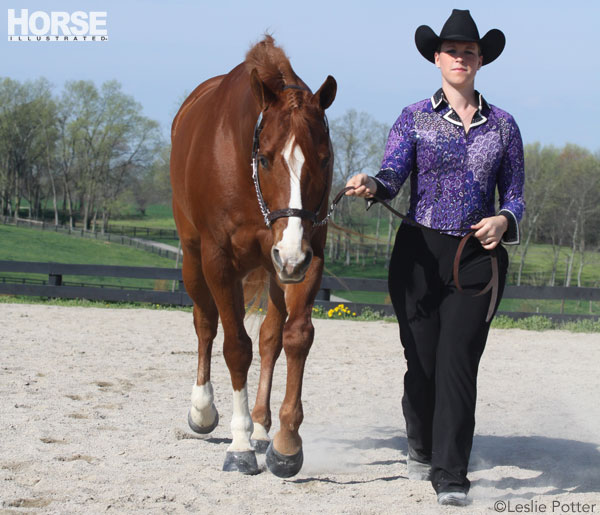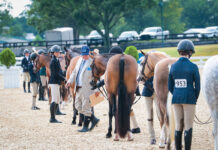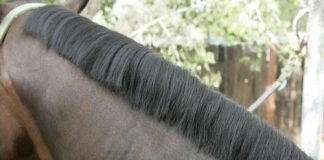 As you anxiously wait at the first cone to begin your showmanship pattern, you watch the exhibitor in front of you. The judge, pen in hand, seems to anticipate an error and is ready to scribble a minus at the slightest misstep. You wonder if the setup was quick enough, the line straight enough and the pivot smooth enough. Were her quarters too fast? Is the judge impressed by a blinged-out outfit, and does a perfectly banded mane make a difference?
As you anxiously wait at the first cone to begin your showmanship pattern, you watch the exhibitor in front of you. The judge, pen in hand, seems to anticipate an error and is ready to scribble a minus at the slightest misstep. You wonder if the setup was quick enough, the line straight enough and the pivot smooth enough. Were her quarters too fast? Is the judge impressed by a blinged-out outfit, and does a perfectly banded mane make a difference?
“We want you to do well,” says Bailey, a longtime AQHA judge and successful horse trainer from Maribel, Wis. “I think there’s probably no one who is as big a cheerleader for showmanship exhibitors than the judges. We want to see a ballet performance that’s synchronized between the horse and handler, is beautiful to watch, and is correct. We’re not your enemies.”
The judges want to see you succeed. Here they offer their insight on what makes a showmanship competitor stand out, in both good and bad ways.
Prep Your Pony
DO:
- Show a well-groomed, properly trimmed horse in a clean and polished halter.
- Style the mane by banding, braiding or roaching it.
DON’T:
- Use bands that are contrasting in color to your horse’s mane if your bands are not straight.
- Have an ill-fitting halter—it should be fitted to the horse’s face and not hang or gap.
“Sometimes I think that we miss the point of the class,” says Bailey. “Exhibitors are so good about getting themselves all cleaned up and ready to go, but their halter may hang off their horse’s nose or it just might not fit.” Bailey reminds exhibitors that in the bigger picture, details like halter fit do matter—showmanship class isn’t just about you looking good and executing a pattern well. “If you reach back to the origin of the class, it’s about how to best show a halter horse,” she says.
Dress to Impress
DO:
- Have polished boots.
- Have a nicely shaped hat.
- Make sure your clothing fits correctly—it shouldn’t be too tight or hanging off your body.
- Have a neat, professional appearance, whether it’s a suit, custom outfit or nice slacks and a shirt.
- Wear an outfit that you are comfortable in.
DON’T:
- Wear pants that are too short—it’s noticeable and distracting to the overall image.
- Enter with muddy boots or a dusty hat.
- Forget to check your outfit from all angles, including the rear view.
“It doesn’t have to be anything fancy or over the top,” says Kearns, a first-year AQHA judge from Grayslake, Ill., with several years experience training All-American Quarter Horse Congress winners and AQHA World champions. “I like a suit just as well as I like something custom-made. Polished boots and a nicely shaped hat make just as big of an impression to me as the outfit itself. Those things show me that you care about the way the overall presentation has turned out.”
Have the Right Attitude
DO:
- Look like you enjoy showing.
- Smile.
DON’T:
- Be uncomfortable, stiff or fake.
“Don’t hide your face under your hat,” says judge and trainer Jeff Greaves of Galva, Ill. “I want to see your expression—whether you’re panicking or comfortable. If you look like you want to be there and you’re happy, I want to place you. As a judge, when you’re sitting there judging four hours of showmanship, you remember those people.”
Managing Maneuvers
AQHA judges use a score sheet to award, penalize or leave a neutral score for each maneuver in the class. With this objective review of your performance, you can see which specific areas you need to improve on.
The Right Set Up
DO:
- Practice so you have control over each foot and can direct your horse’s feet in about two steps, or less than four seconds.
DON’T:
- Leave your horse parked out. A stretched stance is a more severe fault than misaligned feet. A horse needs to be in-frame in order to move to the next element.
“There’s no substitute for time spent,” Bailey says. “When you go to set your horse up in showmanship, the judges will know whether you have a system with your horse—if you can guide each foot where you want it to go—or whether you just push, pull, back up and lead him forward until you hope he falls in place. We’re going to know that.”
Quality Quarters
DO:
- Move at a consistent speed.
- Check your horse and his foot position each time you change sides. The judge wants to see that you are aware of your horse’s alignment.
DON’T:
- Be too quick and snappy; it may appear forced.
- Take only one large step to cross in front of your horse; take natural steps.
Inspection Correction
What should you do if your horse moves during the inspection?
DO:
- Try to correct his feet again.
DON’T:
- Give up on the rest of the pattern; continue as if you didn’t make a mistake.
“Sometimes I’ll see that in exhibitor’s faces,” says Bailey. “Their horse moves and they give up.” Bailey says if you stop showing, she stops judging. Act as if you didn’t make a mistake. Though the judge may have docked points for an error, a strong finish leaves a good impression. It’s also possible the judge didn’t even catch the fault.
Backing
DO:
- Practice often so your horse moves readily off your cue.
- Back straight, steadily and rhythmically. Don’t worry about speed—just be consistent.
DON’T:
- Stand in front of your horse to back him up, a severe and dangerous fault.
- Quit on the back-up just because it’s crooked. Although it’s still a fault, the judges like to see you try to fix your line while you’re backing.
“I would like you to show me that you can handle your horse and fix him on the move,” Greaves says. “I like to see a horse that backs off of your space. If that hand gets back to the horse’s throatlatch, he’s not backing readily.”
Proper Pivots
DO:
- Turn at a steady and consistent speed.
- Anchor the pivot on the right hind foot. A left-hind anchored pivot is not a fault, but per AQHA recommendations, in the case of a tie, a horse with a right-foot pivot will place over one with a left-foot pivot.
- Practice squaring your horse upon completion of the pivot.
DON’T:
- Bend the horse’s head and neck around.
- Be crooked when coming out of the pivot. Line up your horse’s topline with the judge so that he’s straight from the tail through the withers.
- Overstep or understep. Be sure to stop straight and square.
“I like to see your hand not have to work,” says Greaves. “I try to teach my horses to keep the left hind foot caught up with the right. There’s usually four steps with the left hind in a pivot.”
For patterns where you’re required to line up your horse’s hip to the judge and pivot to face the judge, Kearns offers a tip:
“In order for you to nail the hip at the judge, you need to have a system,” she says. “Most horses’ body lengths are three to four steps long. You need to know, for your horse, how many steps it takes to be able to nail that hip on the point you’re trying to hit, and practice so that you’re not leaving it to chance. If you’re over or under after you complete the turn, make the best of it. Go out there and sell it like it’s not a big deal. When you get to the judge, you need to be straight.”
|
Stand Out to the Judge
What do judges really want? The answer might surprise you.
“It’s not always the person who has the fanciest horse or the most expensive outfit or any of that,” Bailey says. “We’re just looking for the person who gets the best performance that day. For judges, it’s really easy to see who has spent time with their horse and knows him as a partner, and who has not.”
Kearns agrees, emphasizing that the handler-horse relationship is very apparent when executing a pattern, whether the two are connected or not.
“I want to see that person be in sync with that horse,” she says. “I want to see that they have practiced, that they have a connection, and that the exhibitor knows what the horse is going to do before he does it.”
For Greaves, exhibitors who display the “four Cs of showmanship” go to the top of his list. Exhibitors must have confidence, control, correctness and consistency. Despite mistakes, Greaves wants to see exhibitors sell their performance. He wants to see handlers enjoying time with their horses.
Now, as you stand at the first cone, awaiting the judge’s nod, you’ll be ready.
As Greaves says, “Go show ‘em what you can do.”
Liked this article? Here’s more showmanship advice:
Perfect Your Showmanship Patterns
A Guide to Showmanship
How to Fit a Halter for Showmanship
Showmanship Success
A freelance writer from Woodstock, Ill., Lisa Kucharski enjoys recreational trail riding and competing in open pleasure shows.
This article originally appeared in the November 2014 issue of Horse Illustrated magazine. Click here to subscribe!







Oh, such good advise, I like the part, do not give up, just because your horse, (or you) made a mistake.
great tips~
Great tips.